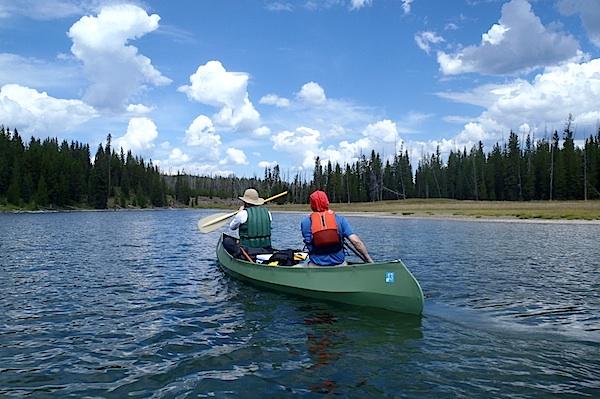
Permitting rules for boating in Yellowstone and Grand Teton national parks have changed this year./Kurt Repanshek
Some of the best paddling waters in the National Park System can be found in Grand Teton and Yellowstone national parks, and for years these two parks offered a great deal: One permit for boating in both parks. Concerns about invasive aquatic species have made that deal a thing of the past.
Beginning this year you need to buy separate permits for paddling, and motorboating, in the two parks. The reason for that, in short, is that Yellowstone existed 18 years before Wyoming became a state, and so the National Park Service retains exclusive jurisdiction over its rules and regs.
With the rise in recent years of invasive aquatic species such as New Zealand mud snails and quagga mussels, national parks are striving to prevent those species from getting much of a foothold in their waters. At Yellowstone this is accomplished by park rangers inspecting boats that come into the park. Once they've cleared your craft, they issue you a boating permit along with an Aquatic Invasive Species sticker to show that your craft has been inspected.
At Grand Teton, the state of Wyoming oversees the invasive species control program. You'll see inspection stations along U.S. 89/191/26 that runs through the Jackson Hole Valley. So while you still need a Grand Teton boating permit to launch your craft in Jackson Lake (or any of the other park lakes open to boating) or down the Snake River, whether it's a canoe, kayak, raft, or powerboat, the state of Wyoming also requires you to purchase an Aquatic Invasive Species sticker and to inspect your craft for any hitch-hikers before you launch.
In Grand Teton, boating permits may be purchased at park visitor centers located in Moose, Jenny Lake, or Colter Bay. Prices vary depending on how long you plan to be in the park, and whether you have a motorized, or non-motorized, craft. The state-required AIS stickers can be purchased on-line from the Wyoming Game and Fish Department, or from regional offices and automated license vendors. Prices vary depending on whether you're a Wyoming resident or not, and whether you're using a canoe, kayak, or raft or a powerboat.
Motorboats are permitted on Jackson Lake and Jenny Lake (10 horsepower maximum). Human-powered vessels are permitted on Jackson, Jenny, Phelps, Emma Matilda, Two Ocean, Taggart, Bradley, Bearpaw, Leigh and String lakes. Sailboats, water skiing and windsurfers are allowed only on Jackson Lake. Jet skis are prohibited on all waters within the park and parkway.
Boat permits for Grand Teton National Park and John D. Rockefeller, Jr. Memorial Parkway are as follows:
Motorized craft, $20 for a 7-day permit
Motorized craft, $40 for an annual permit
Non-motorized craft, $10 for a 7-day permit
Non-motorized craft, $20 for an annual permit.
In Yellowstone, motorized boating is only allowed on Yellowstone and Lewis lakes, while non-motorized boating is allowed on most other park lakes. All types of boat permits may be purchased at the South Entrance, Grant Village Backcountry Office, and the Bridge Bay Ranger Station. The Mammoth Backcountry Office sells only non-motorized permits. The Lewis Lake Campground, Northeast Entrance, Bechler Ranger Station, and the Canyon and Old Faithful Backcountry Offices sell only float tube permits. Permit fees for Yellowstone are $20 for an annual permit for a motorboat and $10 for seven days, and $10 for an annual permit for non-motorized craft and $5 for seven days.



Comments
As stated, you can get a sticker from Wyoming online with out an inspection. Now, what good would that do in keeping the lakes clean?
The theory is that the $$ for the stickers will go toward continued education, and when you get close to water there are inspection stations that you're required to stop at.
We would like to brink kayaks to Jackson lake this summer. My question is: Are we required to take the kayaks off the top of the truck at the inspection station? We pull a trailer for camping and cannot take the kayaks off the truck until the camper is unhitched, which would make it difficult if we had to do this as we are entering the park. Or can the inspection be done after we have set up camp?
JudyG - If you are entering Grand Tetnon NP from the east or south, the state of Wyoming does the inspections. You can have this inspection done at any station in the state and receive your sticker, or you will have to do it at one of the state stations on Hwy 89 in the park. They must be able to examine the interior of your kayak, so I would say yes, you will need to be able to get it to ground level. That isn't an official interpretation, but my in-person experience.
If you are planning on entering Yellowstone, you have to go through the NPS-managed process in that jurisdiction, which is a non-motorized boating permit, and inspection.
Last year, our Yellowstone boat inspector suggested that with our boats absolutely pristine on the outside and having not been in the water for a couple of months, an interior inspection was not necessary. We insisted our four foot ladder be used to take a look, just because we wanted it done (how silly!). We were accomodated. Idaho didn't even ask to look inside. Keeping the outside pristine gives you the best shot at avoiding pulling them down.